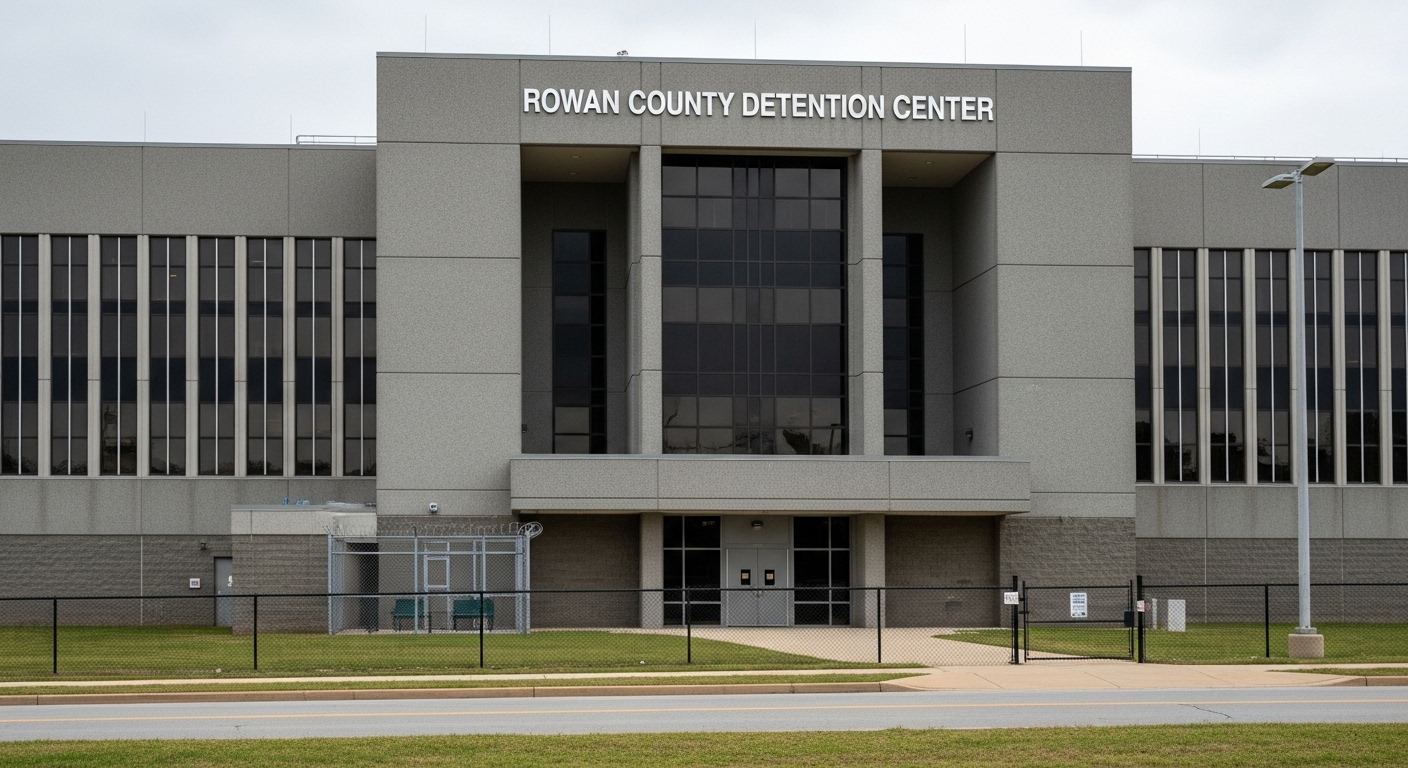In an era marked by calls for justice, transparency, and humane treatment in corrections, the institutions themselves are under scrutiny. No longer can a detention facility be evaluated merely by capacity or security metrics. The most meaningful measure lies in leadership that balances order, rehabilitation, and community accountability. The Rowan County Detention Center is one such institution undergoing change, reimagining what a modern correctional facility can and should be.
This article explores the evolution of Rowan County Detention Center: its mission, leadership challenges, reforms underway, and how it is positioning itself as a model of responsible corrections in the 21st century.
Introducing Rowan County Detention Center
The Rowan County Detention Center refers to facilities operated by Rowan County, North Carolina. It is a 210-bed, direct supervision facility made up primarily of dormitory-style housing units. Additionally, the detention center has an annex facility capable of housing 160 more inmates, consisting of four 40-inmate dormitories. Together, these units aim to provide a self-sufficient operation with housing, food service, laundry, and other internal support services.
Located in Salisbury, North Carolina, the detention center plays a central role in Rowan County’s justice system. The facility enforces rules regarding inmate property, mail, visitation, and internal work assignments. Inmates may work in the kitchen or laundry and must maintain cleanliness of their housing units.
A Leadership Philosophy for Modern Corrections
In many ways, the leadership challenge at Rowan County Detention Center mirrors what progressive corporate or nonprofit leaders face: balancing operational discipline with humane values. The stated mission of the center is to protect the citizens of Rowan County while providing a safe, secure, and humane environment for those housed within the facility, as well as for those conducting business there.
This dual focus — between community protection and inmate dignity — requires a philosophy anchored in:
-
Accountability and transparency: Ensuring oversight, reporting, and responsiveness to public concerns.
-
Rehabilitation emphasis: Viewing detention not solely as punishment, but as a window of opportunity for positive change.
-
Staff training and culture: Investing in corrections staff to treat inmates with respect, manage conflict, and uphold ethical standards.
-
Community collaboration: Partnering with local nonprofits, mental health services, and social reintegration programs to support returning citizens.
By structuring operations around these tenets, the detention center’s leadership can gradually shift culture, reduce recidivism, and rebuild public trust.
Bridging Operations and Community Goals
One of the most notable ambitions of the Rowan County Detention Center is to serve not as an isolated fortress, but as a node in a broader continuum of justice, welfare, and reintegration.
Pretrial Services Integration
Rowan County maintains a pretrial services program designed to reduce overall detention population by identifying those arrested who may be eligible for bond or conditional release. This strategy helps relieve pressure on the facility and ensures that detention is reserved for those who cannot safely await trial outside.
In-facility Programs and Duties
Within the center, inmates may be assigned roles in kitchen and laundry services, contributing toward maintaining the facility and instilling discipline and purpose. Cleanliness, unit upkeep, and structured responsibilities are part of the daily regime.
Support Services & Continuity
The facility strives to function as self-contained but also linked to external support systems. Though details of educational, mental health, or vocational training programs at Rowan are limited, the trend in corrections reform emphasizes these programs as key to lowering recidivism. Leadership can expand alliances with local agencies to funnel detainees into counseling, job training, or reentry services.
Challenges and Opportunities
Operating a detention center in the 21st century brings specific challenges, but also possibilities for innovation and transformation:
Overcrowding & Resource Constraints
Facilities often stretch capacity, especially when judicial backlogs or bail practices delay case resolutions. The annex unit in Rowan’s system helps, but strain remains real. Funding for staffing, maintenance, and programming is finite, requiring difficult trade-offs.
Balancing Security and Humanity
Strict controls are necessary to maintain safety, but treating inmates solely as security risks erodes morale and rehabilitation. Leadership must navigate policies that preserve dignity while upholding security protocols.
Public Perception and Accountability
Detention centers often operate under a veil of anonymity. Incidents—such as misuse of contraband, abuse claims, or neglect—can damage a facility’s credibility. Transparent reporting, effective oversight, and community engagement are essential to maintain legitimacy.
Staff Recruitment & Retention
Corrections officers work in stressful conditions. Hiring processes set minimum age, background checks, drug screening, and health standards. Investing in training, quality of life, fair pay, and professional growth is crucial to retain mission-aligned personnel.
Yet these challenges also invite opportunity:
-
Program innovation: Using technology for virtual visits, telehealth, or digital education to expand offerings without physical expansion.
-
Data-driven reform: Employing metrics—incident rates, case resolution time, recidivism—to guide policy adjustments.
-
Community partnerships: Collaborating with nonprofits and social services to reinforce reentry support.
-
Cultural transformation: Reorienting staff mindset from custodians to facilitators of justice and rehabilitation.
Measuring Impact: Towards a More Humane Model
A transformed Rowan County Detention Center would be evaluated not just by capacity utilization or incident reports, but by broader impact metrics:
-
Reduced Recidivism Rates: Less repeat incarceration indicates more effective reentry support.
-
Faster Case Turnover: Shorter time from arrest to adjudication or release reduces undue incarceration.
-
Staff-Inmate Relations: Surveys or audits gauging levels of respect, grievance handling, and morale.
-
Post-release Outcomes: Tracking employment, education, or housing stability among released individuals.
-
Community Confidence: Public transparency, accessible information, and responsiveness to oversight.
By focusing on these holistic indicators, facility leadership can shift from reactive management to proactive change.
Leadership in Action: Culture, Vision, and Accountability
Transformative leadership at the detention center must align vision and daily practice:
-
Vision-setting: A public statement of goals—safety, dignity, rehabilitation—helps frame decision-making and priority-setting.
-
Model conduct: Leaders and supervisors must exemplify respect, fairness, and consistency in policies and interactions with inmates and staff alike.
-
Training and development: Ongoing education in conflict resolution, mental health awareness, de-escalation techniques, and cultural competency helps staff respond more humanely under pressure.
-
Feedback loops: Grievance committees, anonymous input channels, and regular audits help catch issues early and maintain responsiveness.
-
Partnership alignment: Ensuring local agencies and social services are aligned toward shared goals of justice, support, and reintegration.
Effective leadership must see the detention center not as a silo but as a system node—integral to community, justice, and social repair.
Looking Ahead: The Future of Corrections at Rowan
The journey of the Rowan County Detention Center is one of potential—a facility poised to evolve beyond its foundational role of custody into a space of transformation and community partnership.
Emerging trends that Rowan can embrace include:
-
Trauma-informed care: Recognizing how many inmates arrive from trauma-laden environments and adapting supervision accordingly.
-
Restorative justice programming: Facilitating mediated dialogue between offenders and communities where appropriate.
-
Technology-enhanced services: Using tablets, remote education, or telehealth to expand opportunities inside.
-
Sustainability efforts: Energy-efficient facilities, waste reduction, and cost-saving innovations.
-
Accreditation and standards: Pursuing certifications and external audits to benchmark operations against best practices nationally.
If leadership maintains commitment to humane values, data-driven reform, and community linkage, Rowan County’s detention facilities can serve as a blueprint for other mid-sized jurisdictions seeking to do better.
Conclusion: Toward a New Standard of Corrections
The Rowan County Detention Center stands at a crossroads. On one path, it continues the traditional model of custody and constraint. On the other, guided by forward-looking leadership, it embraces a paradigm of accountability, rehabilitation, and transparency.
This institution’s future depends not only on bricks, bars, and budgets—but on the vision and integrity of those at the helm. If leadership can navigate the tension between security and humanity, Rowan’s model may redefine what a modern detention center can achieve—not just in containing individuals, but in contributing to the safety, dignity, and renewal of its community.

